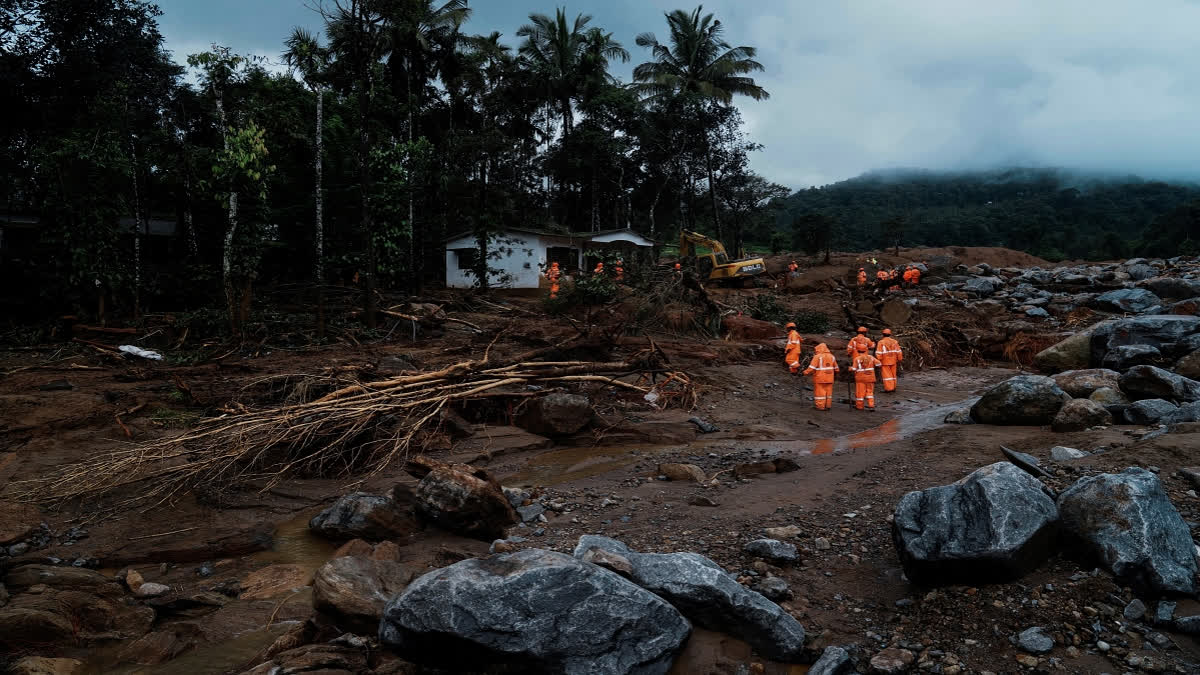New Delhi: Despite warnings and guidelines issued by top environmental experts to conserve the ecologically sensitive Wayanad district in northeast Kerala that is part of the Western Ghats, this week's landslide tragedy that claimed 292 lives eventually happened.
Wayanad is the only plateau in Kerala and forms a continuation of the Mysore Plateau, the southern portion of the Deccan Plateau. It is set high in the Western Ghats with altitudes ranging from 700 to 2,100 metres.
Wayanad is widely recognised as an ecologically sensitive area (ESA). This distinction arises from its rich biodiversity, unique ecosystems, critical water resources, and the challenges posed by human activities and environmental changes. The region is home to a remarkable diversity of plant and animal species. Its forests harbour numerous endemic and endangered species. The region’s vegetation ranges from tropical rainforests to deciduous forests, each supporting a unique array of life forms.
The Western Ghats, where Wayanad is located, is one of the world’s biodiversity hotspots. Wayanad contributes significantly to this status with its high levels of species endemism. Many species of plants, mammals, birds, amphibians, and insects found in Wayanad are not found anywhere else.
However, rapid urbanisation, agriculture, and plantation activities have led to significant habitat fragmentation in Wayanad. This fragmentation threatens the survival of many species, particularly those that require large, contiguous habitats. Logging, conversion of forest land for agriculture, and other human activities have led to deforestation. This loss of forest cover results in reduced biodiversity, soil erosion, and altered hydrological cycles.
It was in view of this that the Centre commissioned studies to ensure the protection of the ecologically sensitive areas in the Western Ghats, including Wayanad. The Western Ghats Ecology Expert Panel (WGEEP), also known as the Gadgil Commission after its chairman Madhav Gadgil, was an environmental research commission appointed by the Ministry of Environment and Forests of India. The primary objective of the commission was to assess the ecology of the Western Ghats and propose measures to protect and sustain its fragile environment. This included assessment of the ecology, zonation of the region, policy recommendations and sustainable development.
The panel proposed classifying the entire Western Ghats into an ecologically sensitive area (ESA). The report classified the 142 taluks within the Western Ghats boundary into three ecologically sensitive zones (ESZs) with varying degrees of protection. In ESZ 1, the highest protection level with strict regulations on developmental activities was recommended. Moderate protection with regulated development was recommended for ESZ 2. For ESZ 3, lesser protection with permissible sustainable development practices was recommended.
In ESZ 1 and ESZ 2, activities like mining, quarrying, and large-scale construction should be banned. The report also recommended phasing out existing harmful activities in these zones. It called for encouraging organic farming, agroforestry, and other sustainable agricultural practices to reduce the ecological footprint.
The panel also called for ensuring the participation of local communities in conservation efforts and decision-making processes. This includes providing them with alternative livelihoods and education on sustainable practices.
Another major recommendation was the establishment of a Western Ghats Ecology Authority (WGEA) to oversee the implementation of conservation measures and ensure compliance with regulations. The commission submitted its report in August 2011.
However, the Gadgil Commission report was criticised for being excessively environment-friendly and not in tune with the ground realities. The criticism came from various stakeholders, including state governments, industries, and local communities, who feared that stringent regulations would hinder economic growth and development. The recommendation for the constitution of a new body called WGEA also came in for much criticism.
In Kerala too, certain sections of people strongly protested the implementation of the report since most of the farmers obtained their livelihood from the hilly regions in Wayanad. During the 20th century, a very large number of people migrated from southern Kerala and acquired forest land in Wayanad and other areas.
Due to the controversy and opposition, the Government of India set up another panel, the Kasturirangan Committee, headed by eminent space scientist K Kasturirangan, to review the Gadgil Commission's recommendations.
The Kasturirangan Commission has sought to balance the two concerns of development and environmental protection, by watering down the environmental regulation regime proposed by the WGEEP's Gadgil report. The Kasturirangan report seeks to bring just 37 per cent of the Western Ghats under the ESA zones — down from the 64 per cent suggested by the Gadgil report.
It recommended a complete ban on mining, quarrying and sand mining in the ESA. It called for phasing out current mining areas within five years or at the time of expiry of the mining lease. It recommended that no thermal power project be allowed and hydropower projects be allowed only after thorough study. It also called for a strict ban on red industries or highly polluting industries.
At the same time, the Kasturirangan report has made several pro-farmer recommendations, including the exclusion of inhabited regions and plantations from the purview of ESA.
However, the Kasturirangan report also came under criticism mainly because it used remote sensing and aerial survey methods for zonal demarcation of land in the Western Ghats. According to the critics, the usage of such techniques, without examining the ground reality, has caused many errors in the report.
Till date, successive governments did not implement the recommendations of both these commissions, which is why the Wayanad tragedy has sparked a huge political debate.
According to DP Kanungo, Chief Scientist and Professor in the Geotechnical Engineering and Geohazards division of the Central Building Research Institute in Roorkee, the Western Ghats, including Kerala, comprise high-grade metamorphic rocks which are very prone to weathering.
"Due to this weathering, they have a thick overburdened material on the hill slopes,” Kanungo, who led a central team to assess the impact of the 2018 devastating floods in Kerala, told ETV Bharat. "These comprise lateritic soil along with boulders."
He explained that the lateritic soil has a lot of clay content. "When there is a lot of rainfall, the lateritic soil has a tendency to retain rather than allow the free drainage of water," Kanungo, who is an expert on landslides, said. "When the soil holds water, a lot of water pressure builds up. It then loses its shear resistance."
He explained that it is then that the mudflow or debris flow starts. It takes away anything, including infrastructure on the riverbed level, that comes on the depositional area.
SP Sati, a leading geologist who heads the Basic and Social Science department at the College of Forestry in the Veer Chandra Singh Garhwali Uttarakhand University of Horticulture and Forestry, shared similar views. He explained that in Wayanad, the whole terrain is made up of a special type of rock that is very old.
"But from what I have observed in photos, the place where the landslides occurred must be basaltic volcanic rock which is thickly weathered in the form of laterite soil cover," Sati said. "In torrential rain, this whole cover was fleshed out."
He explained that, along with water, the whole soil solution enhanced the density of water and the volume of the water causing a huge flash flood downhill.
Following his visit to Kerala in the wake of the 2018 floods, Kanungo had submitted a report based on his observations of the terrain in the Idukki district of the state. He is now likely to make another visit to Kerala, this time to Wayanad, along with a team of experts.
"We should now concentrate more on preparedness and prevention rather than post-disaster management," Kanungo said.



